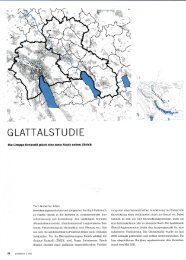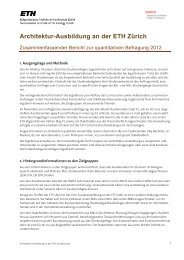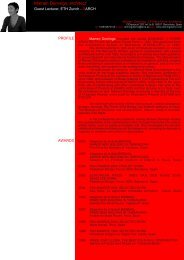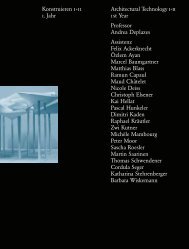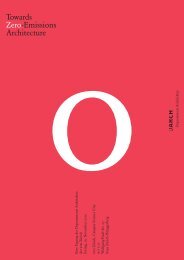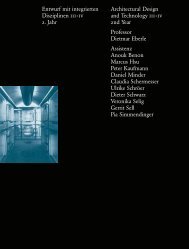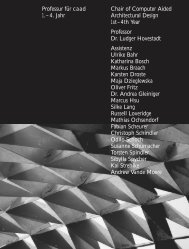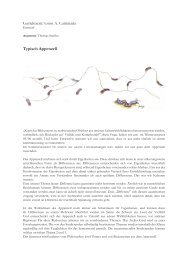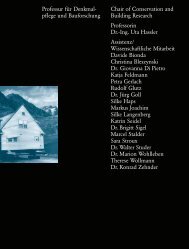Jahrbuch PDF (63MB) - ETH Zurich - ETH Zürich
Jahrbuch PDF (63MB) - ETH Zurich - ETH Zürich
Jahrbuch PDF (63MB) - ETH Zurich - ETH Zürich
Erfolgreiche ePaper selbst erstellen
Machen Sie aus Ihren PDF Publikationen ein blätterbares Flipbook mit unserer einzigartigen Google optimierten e-Paper Software.
Andreas Tönnesmann<br />
Einführung Departement Architektur<br />
deren prominentestem Bauwerk. Im Gegenteil: Das sichtbare,<br />
konstruktiv und ästhetisch verbürgte «Woher» des<br />
Entwurfs, sein Durchkreuzen naheliegender Erwartungen,<br />
seine Orientierung an europäischen, ja spezifisch<br />
schweizerischen Qualitätsmassstäben sind eine entscheidende<br />
Bedingung der Akzeptanz. Architektur gehört<br />
inzwischen zu den mächtigsten Trägern von Identifikation,<br />
die heutigen Kulturen zur Verfügung stehen.<br />
Architektur, Ökonomie, Innovation<br />
Lohnt es sich, in gute Architektur zu investieren? Die Antwort,<br />
so scheint es, muss zwangsläufig «ja» lauten,<br />
ausser man wollte es riskieren, sich unrettbar als Banause<br />
oder Hinterwäldler in Verruf zu bringen. Dabei ist die<br />
Frage bei näherem Hinsehen nicht ohne Tücke. Will man<br />
nämlich das Für und Wider der Aufwendungen, die<br />
Investoren für Architektur zu leisten haben, nach ökonomischen<br />
Kriterien ernsthaft abwägen, so gibt es durchaus<br />
Argumente für ein zögerndes «ja, vielleicht», wenn<br />
nicht sogar für ein klares «nein».<br />
Sicher, Baufaufwendungen sind grundsätzlich sinnvolle<br />
Anlageinvestitionen, die als Erhaltung, Erweiterung<br />
oder Verbesserung von Produktionsmitteln gelten dürfen,<br />
sich oft genug über Jahrzehnte rentieren und damit<br />
die Vernunft auf ihrer Seite haben. Aber Bauinvestitionen<br />
sind nicht von vornherein Ausgaben für anspruchsvolle<br />
Architektur. So schwer es fallen mag, den Unterschied zwischen<br />
dem distinkten Handeln des Architekten und<br />
dem, was man qualitätsneutral als Bauen bezeichnet, klar<br />
zu definieren, so nahe liegt der Verdacht, dass es teurer<br />
wird, wenn von Architektur die Rede ist statt etwa von Gebäudeerstellung.<br />
Denn wo es um Architektur geht,<br />
kommen Kriterien ins Spiel, die sich beim besten Willen<br />
nicht rechnen lassen. Schon der Sprachgebrauch verrät<br />
es: Statt von Planung ist die Rede von Entwurf, statt von<br />
Flächennutzung von räumlichem Gewinn. In solcher Wortwahl<br />
spiegelt sich grundsätzliches Misstrauen gegen<br />
Denkfiguren und Argumentationsweisen, die sich auf gesicherte<br />
Erfahrung berufen, um die Bedrohung durch<br />
das Neue abzuwehren.<br />
Seit es Architektur gibt, sieht sie sich herausgefordert,<br />
über die Anwendung von Erfahrungswissen hinauszugehen:<br />
Begreift sie sich doch als Sublimierung blossen<br />
Bauens und fühlt sich dazu aufgerufen, die Grenzen<br />
10<br />
combination of typical expectations, and its orientation<br />
towards European, indeed specifically Swiss standards<br />
of quality, are crucial factors for public acceptance. Today,<br />
architecture has become one of the most powerful<br />
sources of cultural identification.<br />
Architecture, Economics, Innovation<br />
Does it pay to invest in good architecture? The answer, it<br />
seems, must be ‘Yes’, unless one wishes to risk irrevocable<br />
disrepute as a philistine or hick. Yet, on closer inspection,<br />
the question is not without its difficulties. If one wishes<br />
to seriously consider the pros and cons of the expenditures<br />
investors are obliged to make for architecture, there<br />
are certainly arguments in support of a hesitant ‘Yes,<br />
perhaps’, or even for a clear ‘No’.<br />
Financing construction is certainly, in principle, a<br />
sensible investment. Expenditures count as measures<br />
towards the preservation, expansion, or improvement of<br />
production means, which often translates into longterm<br />
profitability and therefore have reason on their side.<br />
But investment in building does not necessarily mean<br />
expenditure on challenging architecture. As difficult as it<br />
may be to define clearly the difference between the<br />
distinct activity of the architect, from that which could<br />
be called, without reference to quality, building, the<br />
suspicion of greater cost is associated with talk of architecture<br />
rather than simple construction. For in matters<br />
of architecture, criteria come into play that cannot,<br />
despite our best efforts, be anticipated. The very words<br />
we use betray us: rather than planning, we speak of<br />
designing; rather than land use, of gaining space. The<br />
choice of such words reflects a fundamental mistrust<br />
of figures of speech and arguments that appeal to safe experience,<br />
which avert the threat with something new.<br />
Ever since architecture has existed, architects have felt<br />
challenged to go beyond the use of knowledge based<br />
on experience. Architects have viewed their practice as the<br />
sublimation of mere building and feel called upon to<br />
transcend the limits of the predictable. Architecture worthy<br />
of the name attempts to justify its activity and recognize<br />
truths that go beyond the immediate occasion to build.<br />
That is to say, architecture’s approach to opportunistic<br />
buildings has always been from the standpoint of cultural,<br />
not economic, surplus value.<br />
The architect designs, the investor calculates. This observation<br />
draws on a cliché, but often enough accurately<br />
describes reality. Yet astonishingly, there are still investors<br />
who, despite the lack of price guarantees and undeniable<br />
financial risks, continue to stand up for good architecture –<br />
rather than yielding too quickly to the supposed<br />
imperatives of experience, the doable and provable, the<br />
effective, and the advantageous. The recognition of



